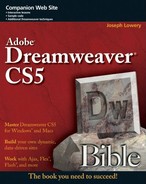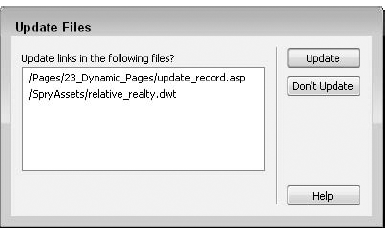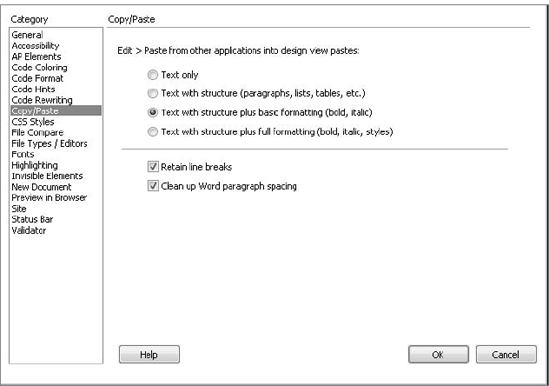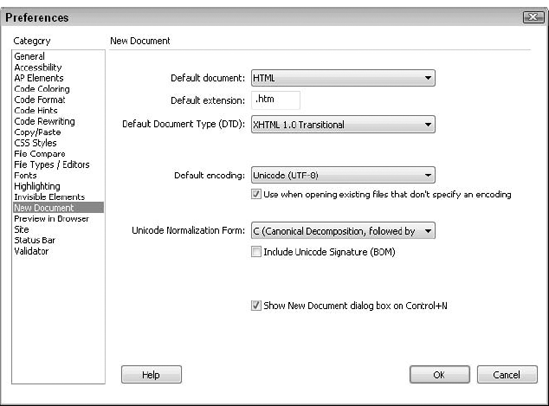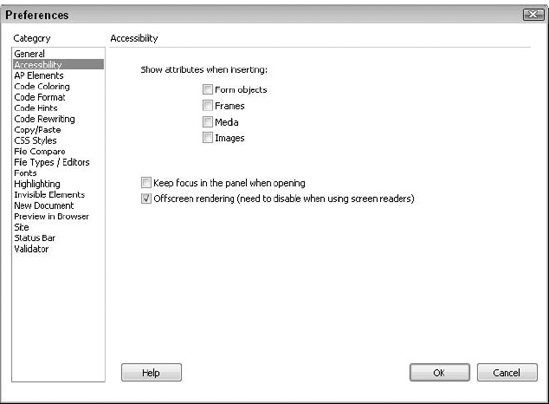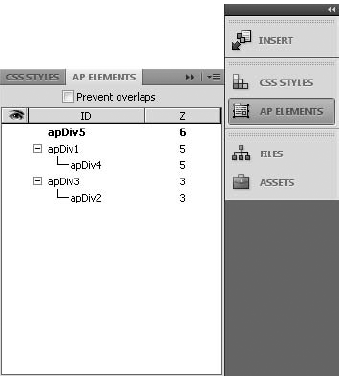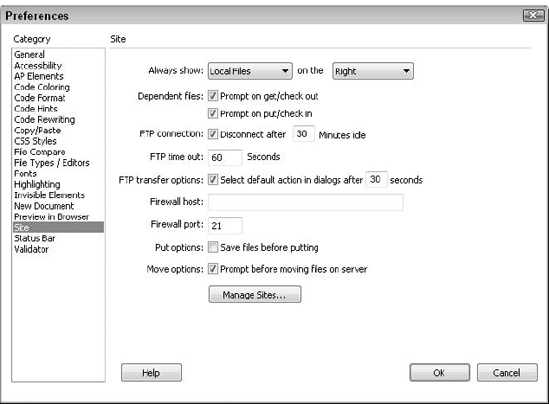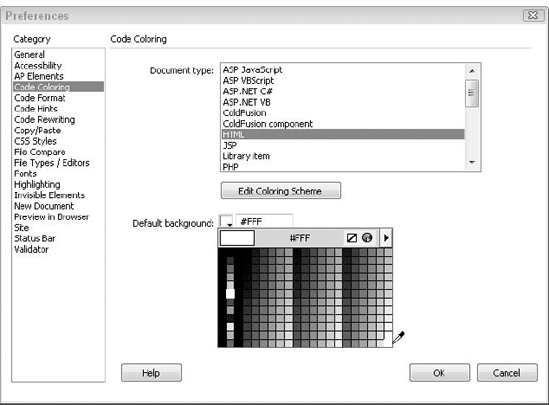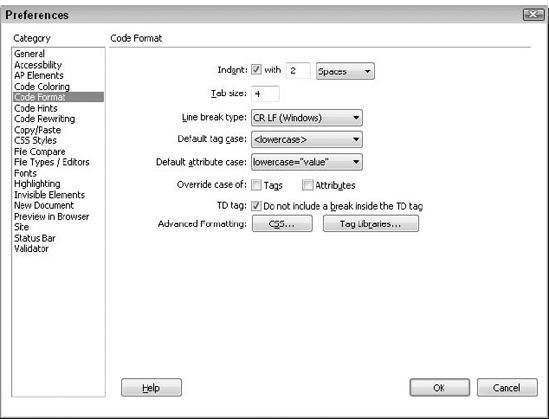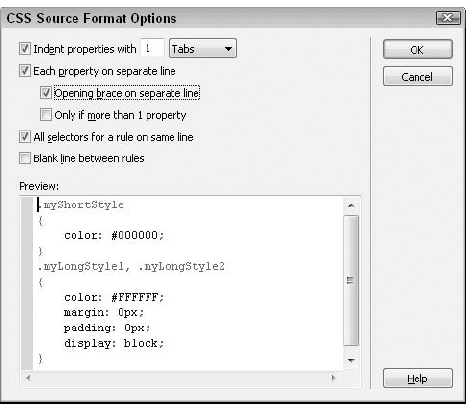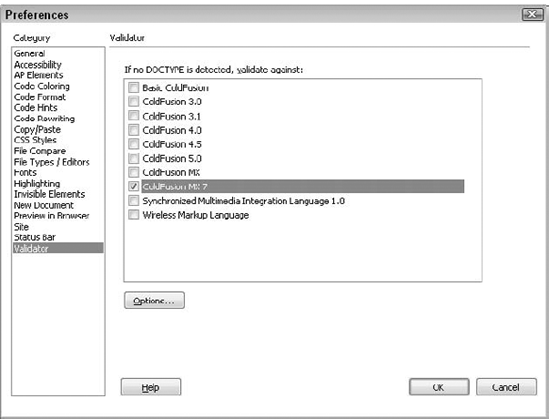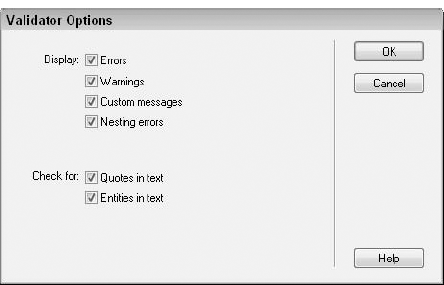Dreamweaver made to order
Customizing Dynamic HTML specs
Extending preferences outside Dreamweaver
Specifying your code formatting
Everyone works differently. Whether you need to conform to a corporate style sheet handed down from the powers that be or you think, "It just looks better that way," Dreamweaver offers you the flexibility to shape your Web page tools and your code output. This chapter describes the options available in Dreamweaver's Preferences and then details how you can instruct Dreamweaver to format source code your way.
The vast majority of Dreamweaver's settings are controlled through the Preferences dialog box. You can open Preferences by choosing Edit
Dreamweaver's General preferences, shown in Figure 3-1, cover the program's appearance, user operation, and fundamental file settings. The appearance of the program's interface may seem to be a trivial matter, but Dreamweaver is a program for designers and coders, to whom work environment is extremely important. These user-operation options, described in the following sections, are based purely on how you, the user, work best.

Figure 3-1. Dreamweaver's General Preferences enable you to change your program's appearance and certain overall operations.
The first area of the General category, Document Options, determines how you work with HTML and other files.
Tip
In choosing all the preferences, including the General ones, you can work in two ways. If you are a seasoned Web designer, you probably want Dreamweaver to work in your established manner to minimize the learning curve. If you're just starting out as a Web-page creator, work with the default options for a while and then try other options. You should know right away which style works for you.
This Macintosh-only checkbox tells Dreamweaver whether you want files to open in tabs instead of separate windows. Documents in tabs keep the workspace orderly and allow you to easily switch between open files. If you click the additional Always Show Tabs option, Dreamweaver will display every document with a tab, even if there is only one.
The welcome screen is a very helpful innovation that gets you up and running right away in Dreamweaver — whether you're just starting out or in the middle of editing a full site. If you're new to the program, Dreamweaver's welcome screen gives you quick access to tutorials and a tour of the key features. After you've worked with the program for a while, you'll appreciate the immediate access to the more recently opened files and one-click creation of static or dynamic pages. The welcome screen displays when Dreamweaver launches or when no document is currently open.
The welcome screen is extremely handy, but if it doesn't fit with your workflow, you can disable it. Clear the Show Welcome Screen checkbox and, depending on your other settings and actions, the next time Dreamweaver opens you see either a blank, documentless environment or your previously opened files.
The welcome screen changes from time to time because it includes a Flash movie (located in the lower-right corner) that uses dynamically set parameters to display different information if you're connected to the Internet when running Dreamweaver.
In an ideal world, a Web designer works on one page at a time, carefully crafting each and every detail. Well, it's far from an ideal world and often designers are working on several pages simultaneously — and over multiple sessions. If your workflow fits into this real-world model, the Reopen Documents On Startup option makes your life a little easier.
When I'm working on a Web application, I often have four to six pages (or more) open simultaneously. If I'm continuing my work from one day to the next, the first thing I do is to make sure I've opened all the files that I need. With the Reopen Documents On Startup option selected, Dreamweaver automatically opens any files left unclosed when I last quit the program. If this option is left unselected, you see either the welcome screen or a documentless environment.
Read-only files have been locked to prevent accidental overwriting. Optionally, Dreamweaver can warn you when such a file is opened. The warning is actually more than just an alert, however. Dreamweaver provides an option on the warning dialog box to make the file writable (or check it out if you're using the Check In/Check Out feature). Alternatively, you can just view the file.
Note
See Chapter 31 for more on the Check In/Check Out feature.
Although Dreamweaver enables you to edit the file either way, if the document is still read-only when you save your changes, the Save As dialog box opens, and you're prompted to store the file under a new name.
With the Enable Related Files option selected, Dreamweaver displays a link to any file referenced in the primary source document in the Related Files bar. Click any related file link to view its source code while continuing to show the rendered main page in Display or Live view. Related files can be CSS external files, server-side includes, Library items, JavaScript source files, or any other type of file that is linked, included, or imported.
The associated Discover Dynamic Related Files list determines whether you want Dreamweaver to process the server-side code in a PHP, ColdFusion, or ASP page to identify any additional related files on demand (the default Manually option), all the time (Automatically) or never (Disabled). Most content management systems such as WordPress, Drupal, or Joomla rely on server-side code to combine files for needed functionality. With the Discover Dynamic Related Files option, you can locate specific functions or styles that would otherwise remain hidden.
Note
Chapter 5 has all the details on how to make the most of the Related Files feature.
As your site grows in complexity, keeping track of the various links is an increasingly difficult task. Dreamweaver has several enhanced features to help you manage links, and the Update Links When Moving Files option is one of them. Dreamweaver can check each link on a page when a file is moved — whether it is the Web page you're working on or one of the support files, such as an image, that goes on the page. The Update Links option determines how Dreamweaver reacts when it notes an altered link.
By default, the Update Links When Moving Files option is set to Prompt, which causes Dreamweaver to alert you to any link changes and requires you to verify the code alterations by clicking the Update button, as shown in Figure 3-2. To leave the files as they are, click the Don't Update button. You can elect to have Dreamweaver automatically keep your pages up-to-date by selecting the Always option from the Update Links drop-down list. Finally, you can select the Never option, and Dreamweaver ignores the link changes necessary when you move, rename, or delete a file.
As a general rule, I keep my Update Links option set to Always. It is a very rare circumstance when I intentionally maintain a bad link on my Web page. Likewise, I recommend using the Never option with extreme caution.
The second main section of the General category of the Preferences dialog box consists of numerous checkbox options you can turn on or off. Overall, these options fall into the user-interaction category, reflecting how you like to work. Take the Show Dialog When Inserting Objects option, for example. Some Web creators prefer to enter all their attributes at one time through the Property inspector and would rather not have dialog boxes appear for every inserted object. Others want to get their file sources in immediately and modify the rest later. The choice depends on how you want to work. The following sections describe various other options.
By default, almost all the objects that Dreamweaver inserts — via either the Insert panel or the Insert menu — open an initial dialog box to gather needed information. In some cases, the dialog box enables you to input a URL or browse for a source file. Turning off the Show Dialog When Inserting Objects option causes Dreamweaver to insert a default-sized object, or a placeholder, for the object in this circumstance. You must then enter all attributes through the Property inspector.
Tip
To selectively avoid the prompts, leave this option checked, but press Ctrl+click (Option+click) on an object to skip the prompt.
Some computer representations of languages, primarily Asian languages, require more raw descriptive power than others. The ideogram for snow, for example, is far more complex than a four-letter word. These languages need twice the number of bytes per character and are known as double-byte languages. In versions of Dreamweaver before 2, all double-byte characters had to go through a separate text-input window, instead of directly into the Document window.
Dreamweaver now simplifies the page creation process for double-byte languages with the Enable Double-Byte Inline Input option. If selected, this option enables double-byte characters to be entered directly into the Document window. To use the old method of inserting such characters, deselect this option.
This may seem like a small thing, but this nifty little feature is one of my favorites. If the Switch To Plain Paragraph After Heading option is not enabled, pressing Enter (Return) after a heading tag (<h1> or <h2>, for example) causes the next line to maintain the heading style. Select the Switch To Plain Paragraph After Heading option so that the next line is a standard paragraph (<p>) tag.
Use this option to speed up your workflow. You'll almost always want a heading followed by a plain paragraph. This option gets rid of one more click of the mouse or shortcut key, making your workflow that much faster.
Some designers prefer adding two spaces after every period, or they like to use multiple spaces to indent paragraphs to maintain a print-type appearance. Without this option selected, this type of spacing requires that you press Ctrl+Shift+Space (Command+Shift+Space) to add an to the document. Select the Allow Multiple Consecutive Spaces option, and Dreamweaver adds the necessary code for you, without requiring the additional keyboard shortcut.
Tip
This option may seem wonderful at first, but I recommend leaving it unchecked. Having a single space after a sentence is the standard online and is even becoming standard practice in most print applications. (You'll find no double spaces in this little tome.) Enabling this option only encourages bad habits.
In new HTML and XHTML standards, the <b> and <i> tags are deprecated because they don't imply any structural significance to the text they surround. Many screen readers may even completely ignore the <b> and <i> tags. Check the Use <strong> And <em> In Place Of <b> And <i> box to use the more syntactically correct <strong> and <em> tags in their place.
The option to use <strong> and <em> tags enables you to create more descriptive HTML code. Individuals using screen readers benefit, and you make your code more syntactically correct, further separating style from content.
Sometimes Dreamweaver adheres a bit too strictly to the rules for my taste — and this preference addresses one of those times. In Dreamweaver templates, editable regions define areas of the page that can be altered in the pages derived from templates. Most often, designers wrap editable regions around block elements such as headings or paragraphs. However, there are occasions when it is advantageous to make just the content within block tags editable and lock the surrounding tags themselves. I, for example, apply this technique when I want a template-derived page to always start with a single <h1> heading, but know that the heading will always be different. Dreamweaver regards this approach with suspicion because such an editable region will not allow the user to press Enter (Return) and add more block-level tags.
To prevent novices from inadvertently limiting the expansion of content within an editable region, Dreamweaver displays an alert whenever a template is saved that has an editable region within a block element. You can continue the save — and the subsequent updating of template-derived pages — or you can cancel and correct the situation. In previous versions, Dreamweaver displayed this error without recourse, even when the coding it was protesting was intentional. By disabling the Warn When Placing Editable Regions Within <p> Or <h1>-<h6> Tags option, you can avoid having to repeatedly dismiss the alert.
If you're new to Dreamweaver and its template technology, I recommend that you enable this option. Doing so will likely save you grief on your initial template-derived pages and prevent you from having to redo the templates. However, once you've worked with templates for a while, I suggest you disable this option; the technique of embedding editable regions within block tags is a common one and not having to acknowledge the alert over and over again is a major time-saver.
Almost every Dreamweaver action, except the mouse click, is listed in the History panel. These steps can be undone by moving the slider on the History panel or choosing Edit
Although 50 history steps are more than enough for most systems, you can alter this number by changing the Maximum Number Of History Steps value. When the maximum number of history steps is exceeded, the oldest actions are wiped from memory and made unrecoverable. The history steps are not discarded when a file is saved.
The Spelling Dictionary option enables you to select a spell-checking dictionary from any of those installed. In addition to the standard English-language version, which has 15 options — Danish, Dutch, English (American), English (British), English (Canadian), Finnish, French, German (Classic), German (New Spelling), Italian, Norwegian (Bokml), Portuguese (Brazilian), Portuguese (Iberian), Spanish, and Swedish — additional dictionaries exist online. As of this writing, dictionaries in the following other languages are also available: German, Spanish, Swedish, French, Italian, Brazilian-Portuguese, and Catalan. You can download these dictionaries from Adobe's Dreamweaver Exchange at www.adobe.com/support/dreamweaver/documentation/dictionary.html. After a dictionary is downloaded, save the .dat file in the ConfigurationDictionaries folder and restart Dreamweaver.
To select a different dictionary for spell checking, select the Dictionary option button and choose an item from the drop-down list. Dreamweaver also maintains a personal dictionary (although it's not visible on the list) to hold any words you want Dreamweaver to learn during the spell-checking process. So the next time you spell check a technical document, just click Add for each word Dreamweaver catches that you want it to remember. That word is added to the personal dictionary, and you never have to worry about it again.
By their nature, all HTML markup tags remain unseen to one degree or another when presented for viewing through the browser. You may want to see certain elements while designing a page, however. For example, adjusting line spacing is a common task, and turning on the visibility of the line break tag <br> can help you understand the layout.
Dreamweaver enables you to control the visibility of 13 different codes, as well as dynamic data and server-side includes — or rather their symbols, as shown in Figure 3-3. When, for example, a named anchor is inserted, Dreamweaver shows you a small gold shield with an anchor emblem. Not only does this shield indicate the anchor's position, but you can also manipulate the code with cut-and-paste or drag-and-drop techniques. Moreover, clicking a symbol opens the pertinent Property inspector and enables quick changes to the tag's attributes.
Tip
Temporarily hide all invisible elements by deselecting View
The 13 items controlled through the Invisible Elements panel are as follows:
Named Anchors
Scripts
Comments
Line Breaks
Client-Side Image Maps
Embedded Styles
Hidden Form Fields
Form Delimiter
Anchor Points For AP Elements
Anchor Points For Aligned Elements
Visual Server Markup Tags (ASP, CFML, . . . )
Nonvisual Server Markup Tags (ASP, CFML, . . . )
CSS Display: None
Most of the Invisible Elements options display or hide small symbols in Dreamweaver's visual Document window. Several options, however, show an outline or another type of highlight. Turning off Form Delimiter, for example, removes the dashed line that surrounds a form in the Document window.
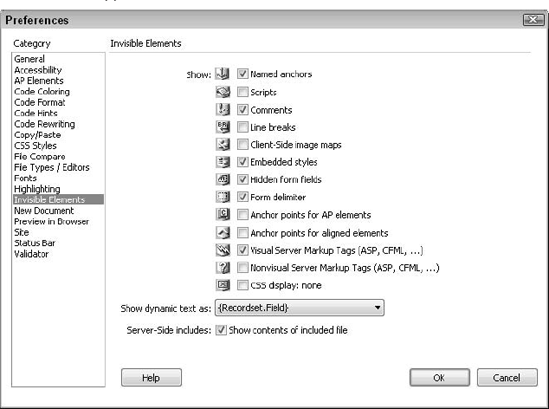
Figure 3-3. You can show or hide any or all of the 13 invisible elements listed in the Preferences dialog box and determine the appearance of recordset fields and includes.
Tip
You may have noticed that the PHP, ColdFusion, Active Server Page, and .NET tags are combined into one symbol, Server Markup tags. Dreamweaver's capability to handle dynamic pages generated by databases makes these invisible elements essential. I generally leave the Nonvisual Server Markup Tags option unchecked because these icons flag server-side coding in the page and tend to interrupt the flow of the design.
Dreamweaver-developed pages often include references to dynamic text. Dynamic text is replaced by an entry from a recordset when the page is processed by the application server. Dreamweaver uses what is called dot notation in programming circles to fully display these names, such as {rsMaillist.EmailAddress}, enclosed in curly braces. When designing a page, the field names may be longer than the actual data, and the full dot notation becomes a visual hindrance rather than an aid. In these situations, you may want to use Dreamweaver's alternative dynamic text syntax, an empty pair of curly braces: {}. Enable this option from the Show Dynamic Text As drop-down list on the Invisible Elements panel.
When designing dynamic sites you may often use server-side includes to speed development and updates. Unfortunately, rendering these in the design window can often cause problems if you are conditionally including multiple files. Clear the Show Contents Of Included File option to disable rendering your server-side includes.
Dreamweaver is extremely extensible — custom functions are automatically incorporated, server-side markup is more acceptable, and more third-party tags are supported. Many of these features depend on hidden capabilities that are not noticeable in the final HTML page. The Web designer, however, must consider them. Dreamweaver employs user-selectable highlighting to mark areas on a Web page under construction.
Mouse-Over
Editable Regions
Nested Editable Regions
Locked Regions
Library Items
Third-Party Tags
Untranslated Live Data
Translated Live Data
The Highlighting panel of the Preferences dialog box, shown in Figure 3-4, enables you to choose the highlight color for eight different types of extended objects.
In each case, select the color swatch to open Dreamweaver's color picker and choose a highlight color. Then, use the Eyedropper to pick a color from the Web-safe palette or from the desktop. After you've chosen an appropriate color, be sure to select the related Show checkbox so that the highlighting is displayed; all but the highlighting for nested editable regions can be toggled to be shown or hidden.
The Status Bar is a handy collection of different tool sets: the Tag Selector, the Select tool, the Hand tool, the Zoom tool, the Set Magnification pop-up menu, the Window Size pop-up menu, and the Connection Speed indicator. The Status Bar category of the Preferences dialog box, shown in Figure 3-5, controls options for two of the tools.
The Window Sizes list at the top of the Status Bar category shows the current options for the Window Size pop-up menu. This list is completely user-editable and enables you to add new window sizes, modify existing dimensions, add descriptions, or delete rarely used measurements.
As discussed in Chapter 2, the Window Size pop-up is a Dreamweaver feature that enables you to instantly change your screen size so that you can view and build your page under different monitor conditions. To change any of the current dimensions, simply click the measurement you want to alter and enter a new value. You can also change any description of the existing widths and heights by clicking in the Description column and entering your text. Although you can enter as much text as you like, it's not practical to enter more than about 15 to 20 characters.
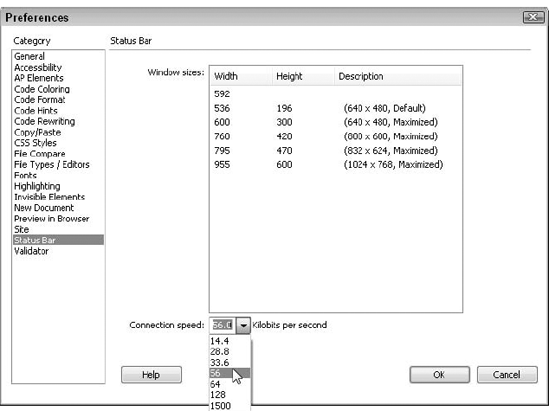
Figure 3-5. Use the Status Bar category to evaluate your real-world download times and control the size of your Document window.
To enter a new set of dimensions in the Window Sizes list box, follow these steps:
From the Status Bar category of the Preferences dialog box, locate the last entry in the current list. If the last entry is not immediately available, use the vertical scroll bar to move to the end.
Click once in the Width column on the line below the last entry.
Enter the desired width of the new window size in pixels.
Press Tab to move to the Height column.
Enter the desired height for the new window size.
Press Tab again.
Optionally, you can enter short, descriptive text in the Description column, and then press Tab when you're finished.
To continue adding new sizes, repeat Steps 2 through 6. Click OK when you finish.
Warning
You don't have to enter the word "pixels" or the abbreviation "px" after your values in the Width and Height columns of the Window Sizes list box, but you can. If you enter any dimensions under 20, Dreamweaver converts the measurement to its smallest possible window size, 20 pixels.
Dreamweaver understands that not all access speeds are created equal, so the Connection Speed option enables you to check the download time for your page (or the individual images) at a variety of rates. The Connection Speed setting evaluates the download statistics in the status bar. You can choose from seven preset connection speeds, all in kilobits per second: 14.4, 28.8, 33.6, 56, 64, 128, and 1,500. The lower speeds (14.4 through 56) represent various dial-up modem connection rates — if you are building a page for the mass market, you might still consider selecting 56. Use the 128 setting if your audience connects through an ISDN line. If you know that everyone will view your page through a direct LAN connection, change the connection speed to 1,500. You are not limited to these preset settings. You can type any desired speed directly into the Connection Speed text box. If you find yourself designing for an audience using DSL or cable modems, change the Connection Speed to 150 or higher.
Refinement is often the name of the game in Web design, and quick access to your favorite modification tools — whether you're modifying code, graphics, or other media — is one of Dreamweaver's key features. The File Types / Editors category, shown in Figure 3-6, is where you specify the program you want Dreamweaver to call for any file type you define.
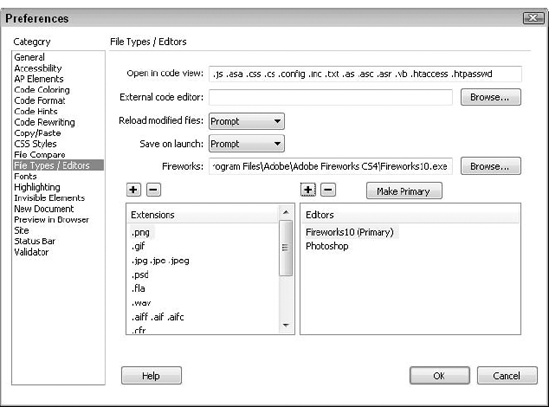
Figure 3-6. Assign your favorite HTML, graphics editors, and more through the newly extended File Types / Editors category of the Preferences dialog box.
It's not just an HTML world — many code types are commonly found on a Web designer's palette such as XML, XSL, PHP, and Perl. Dreamweaver's internal code is full-featured enough to handle a wide variety of code and, with the Open In Code View option, you can determine which types you'd like it to handle. By default, JavaScript (.js), text (.txt), and Active Server Application (.asa) files are automatically opened in Code view. Dreamweaver attempts to open any other selected file type in Design view.
If you find yourself hand-editing other file types, such as XML files, you can add their extension to the Open In Code View field. Separate extensions with a space, and be sure to begin each one with a period.
Dreamweaver recognizes the importance of your choice of a text editor. Although Dreamweaver ships with two extremely robust code editors — as well as its excellent built-in code editor — you can opt to use any other program. To select your editor, enter the path in the External Code Editor text box or click the Browse button to choose the appropriate executable file.
Two editors, BBEdit for Macintosh and HomeSite for Windows, are integrated with Dreamweaver to varying degrees. Both of the editors can be called from within Dreamweaver, and both have Dreamweaver buttons for returning to the main program — switching between the editor and Dreamweaver automatically updates the page. Like Dreamweaver's internal HTML editor, BBEdit highlights the corresponding code to a selection made in Dreamweaver; this property does not, however, extend to HomeSite. You specify and control your external editor selection with the options listed in the sections that follow.
Dreamweaver for Macintosh ships with this option activated. If you prefer to use another editor, deselect this option. Clear this box to enable the External Code Editor fields.
The drop-down list for the Reload Modified Files setting offers three choices for working with an external editor:
Prompt: Detects when files are updated by another program and enables you to decide whether to update them within Dreamweaver.
Always: Updates the file in Dreamweaver automatically when the file is changed in an outside program.
Never: Assumes that you want to make all updates from within Dreamweaver yourself.
Personally, I prefer to have Dreamweaver always update my files. I find that it saves a couple of mouse clicks — not to mention time.
Any external HTML editor — even the integrated HomeSite or BBEdit — opens and reads a previously saved file. So, if you make any changes in Dreamweaver's visual editor and switch to your editor without saving, the editor shows only the most recently saved version. You have three options to control this function:
Prompt: Determines that unsaved changes have been made and asks you to save the file. If you do not, the external editor reverts to the last saved version.
Always: Saves the file automatically before opening it in the external editor.
Never: Disregards any changes made since the last save, and the external editor opens the previously saved file.
Here, again, as with Reload Modified Files, I prefer to always save my files when switching back and forth.
Tip
If you try to open a file that has never been saved in an external editor, Dreamweaver prompts you to save it regardless of your preference settings. If you opt not to save the file, the external editor is not opened, because it has no saved file to display.
Dreamweaver enjoys a tight integration with its sister graphics program, Adobe Fireworks. To empower Dreamweaver with Fireworks capabilities, such as Launch and Edit, Dreamweaver has to know where Fireworks is installed. If you install Studio 8, the path to Fireworks is prefilled for you and shown in this option. If you install Fireworks separately, you'll need to click Browse and locate the Fireworks executable.
Dreamweaver has the capability to call an editor for any specified type of file at the click of a button. For example, when you import a graphic, you often need to modify its color, size, shape, transparency, or another feature to make it work correctly on the Web page. Rather than starting your graphics program independently, you load the image, make the changes, and resave the image. Dreamweaver enables you to send any selected image directly to your editor. After you've made your modifications and saved the file, the altered image appears automatically in Dreamweaver.
The capability to associate different file types with external editors applies to more than just images in Dreamweaver. You can link one or more editors to any type of media — images, audio, video, even specific kinds of code. The defined external editor is invoked when the file is double-clicked in the Files panel. Because the editors are assigned according to file extension, as opposed to media type, one editor can be assigned to GIF files and another to JPEGs. The selection is completely customizable.
Note
If you have the same file type both defined to Open In Code View and set up in the editor list, the file defaults to opening in Code view.
When you double-click a file in the Files panel, that file type's primary editor runs. Dreamweaver offers the capability to define multiple editors for any file extension. You might, for instance, prefer to open certain JPEGs in Fireworks and others in Photoshop. To choose an alternative editor, right-click (Control+click) the filename in the Files panel and select the desired program from the Open With menu option. The Open With option also enables you to browse for a program.
To assign an editor to an existing file type, follow these steps:
Select the file type from the Extensions list.
Click the Add (+) button above the Editors list. The Add External Editor dialog box opens.
Locate the application file of the editor and click Open when you're ready. You can also select a shortcut to or alias for the application.
If you want to select the editor as the primary editor, click Make Primary while the editor is highlighted.
To add a new file type, click the Add (+) button above the Extensions list and enter the file extension — including the period — in the field displayed at the bottom of the list. For multiple file extensions, separate each extension with a space, as shown here:
.doc .dot .rtf
Tip
Looking for a good, almost-all-purpose media editor? QuickTime Pro makes a great addition to Dreamweaver as the editor for AIFF, AU, WAV, MP3, AVI, MOV, animated GIF, and other files. The Pro Player is wonderful for quick edits and optimization, especially with sound files. It's available from the Apple Web site (www.apple.com/quicktime) for both platforms for around $30.
Finally, to remove an editor or a file extension, select it and click the Delete (−) button above the corresponding list. Note that removing a file extension also removes the associated editor.
Note
Make sure that your graphics program is adept at handling the three graphic formats used most on the Web: GIFs, JPEGs, and PNG images. One optimal choice is Adobe Fireworks, a graphics editor designed specifically for the Web, which integrates seamlessly with Dreamweaver. In fact, it integrates so nicely that this book includes an entire chapter on it, Chapter 24.
Dreamweaver has beefed up its copy-and-paste prowess when it comes to text. Now, when a copied section of any text document — including those from Microsoft Office — is pasted into Dreamweaver, Dreamweaver automatically converts the formatting to HTML, preserving the full range of original formatting. Moreover, you can even drag entire documents right onto the Dreamweaver Web page — what happens next depends on the settings in the Copy/Paste preferences, shown in Figure 3-7.
With the Copy/Paste options, you can determine how text from documents outside of Dreamweaver is added to the page. Best of all, this feature works hand-in-glove with the new Paste Special command, which gives you the opportunity to change the settings on a case-by-case basis.
The four main Copy/Paste options are:
Text Only: Pastes completely unformatted text; even line breaks or paragraphs are removed.
Text With Structure: Pastes unstyled text while retaining structured elements such as lists, paragraphs, line breaks, and tables.
Text With Structure Plus Basic Formatting: Adds simple formatting, such as bold, italic, and underline, to structured text. If the text is copied from an HTML document, the pasted text retains any HTML text style tags, including
<b>,<i>,<u>,<strong>,<em>,<abbr>, and<acronym>.Text With Structure Plus Full Formatting: Pasted text keeps all structure and formatting. If the copied text retains inline CSS styles, Dreamweaver pastes them as well.
Two other options are available for modifying your copy/paste preferences. The Retain Line Breaks option maintains line breaks in pasted text; if you choose Text Only, this option is disabled. The Clean Up Word Paragraph Spacing option works with the Text With Structure and Text With Structure Plus Basic Formatting choices to remove additional space between paragraphs.
Dreamweaver has greatly improved the New Document interface. You can now quickly choose which type of document you want to create, as well as select from built-in page designs and CSS. The New Document dialog appears each time you press Ctrl+N (Command+N) or choose File
The Default Document menu contains all the default document types in the New Document dialog box (File
You can define a default extension for each document type in Dreamweaver. This means that if your server requires all ASP files to have the .dan extension and all your ColdFusion pages to have the .joe extension, you can change the extension to fit your needs. Simply enter the desired file extension, with a leading period, in the Default Extension field.
A document type, or DTD, is a line of code found at the top of an HTML page that lets the browser know how to render the following file. DTDs are also used to validate the page against a chosen set of specifications.
The Default Document Type option enables you to select which DTD, if any, you'd like to include by default. This option is originally set to XHTML 1.0 Transitional, a standard now among many Web designers. You can choose from other XHTML and HTML selections including HTML 5. You can always change the DTD by choosing File
The Encoding options determine the character set in which you want your Web page to be displayed. The Default Encoding option for the English version of Dreamweaver is initially set to Western European. Developers of multilanguage sites may find it better to choose Unicode (UTF-8) as the encoding option. New pages use whatever choice you make from the Default Encoding list; however, the encoding can be altered in the Page Properties on a per-page basis. When opening existing pages without an encoding, the selected encoding is added if the accompanying option (Use When Opening Existing Files That Don't Specify An Encoding) is checked.
The Unicode Normalization Form list enables you to choose how the Unicode characters are converted to binary format. The Include Unicode Signature option determines whether a byte order mark (BOM) is attached to the file. Neither option has any effect unless the Default Encoding is set to Unicode (UTF-8).
If you consistently use the same document type, clear the Show New Document Dialog Box On Control+N (Command+N) box to prevent the New Document dialog box from coming up when you press Ctrl+N (Command+N). This can measurably speed up creating new documents. Leave this box checked to see the New Document dialog box every time you create a new document.
Evolution of the Web and its language, HTML, never ends. New features emerge, often from leading browser developers. A developer often introduces a feature similar to those marketed by his competitors but that works in a slightly different way. The HTML standards organization — the World Wide Web Consortium, also known as the W3C — can then endorse one approach or introduce an entirely new method of reaching a similar goal. Eventually, one method usually wins the approval of the marketplace and becomes the accepted coding technique.
To permit the widest range of features, Dreamweaver enables you to designate how your code is written to accommodate the latest Web features: accessibility options, AP elements, and style sheets. The default preferences for these elements offer the highest degree of cross-browser and backward compatibility. If your Web pages are intended for a more specific audience, such as a Netscape Navigator–only intranet, Dreamweaver enables you to take advantage of a more specific feature set. Furthermore, Dreamweaver also gives you control over its Layout mode, enabling you to set options globally or on a site-by-site basis.
Dreamweaver offers much improved support for accessibility options. With the passing of the Section 508 statute (www.usdoj.gov/crt/508/508home.html), all government agencies are required to make their sites as accessible as possible (and making your own site accessible isn't such a bad idea). Dreamweaver makes that transition just a little easier for you by allowing you to manage which accessibility options you want to enable by using the accessibility preferences, as shown in Figure 3-9.
Check the box next to each tag for which you want to view additional accessible options when you insert that object into your page. If you check the box next to Form Objects, you get an expanded dialog the next time you insert any form element, such as a text field or checkbox.
Inserting a form element with the accessibility options enabled gives you a much wider range of options, including labels and the capability to set an access key and tab index. The same holds true for frames, media, and images.
When Dreamweaver opens a panel, such as the Files panel or CSS Styles panel, it typically returns focus to the Document window, either in Design view or Code view. If you're using a screen reader, you'd then need to locate and select the opened panel to work in it. Apply the Keep Focus In The Panel When Opening option to maintain selection in the opened panel.
Dreamweaver uses double buffering (drawing into an off-screen bitmap before drawing to the screen) to prevent flickering. Unfortunately, this confuses screen readers, devices that help blind people use applications (such as Dreamweaver). If you're using a screen reader, disable this option.
Aside from helping you control the underlying coding method for producing AP elements, Dreamweaver enables you to define the default AP element. An AP element is a page element, often a <div> tag that is absolutely positioned. This capability is especially useful during a major production effort in which the Web development team must produce hundreds of AP elements spread over a Web site. Being able to specify in advance the initial size, color, background, and visibility saves numerous steps — each of which would have to be repeated for every AP element. Figure 3-10 shows the layout of the AP Elements category of the Preferences dialog box. The controls accessible through the AP Elements category are described in the following sections.
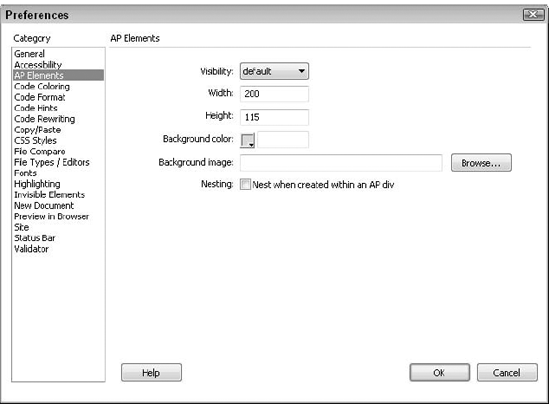
Figure 3-10. In the AP Elements category of Preferences, you can predetermine the structure of the default Dreamweaver AP element.
AP elements can be either visible or hidden when the Web page is first loaded. An AP element created using the default visibility option is always displayed initially; however, no specific information is written into the code. Selecting Visible forces Dreamweaver to include a visibility:visible line in your AP element code. Likewise, if you select Hidden from the Visibility options, the AP element is initially hidden.
Use the Inherit option when creating nested AP elements. Creating one AP element inside another makes the outer AP element the parent and the inner AP element the child. If the parent AP element is visible and the child AP element is set to visibility:inherit, the child is also visible. This option makes it possible to affect the visibility of many AP elements with one command — hide the parent AP element, and all the inheriting child AP elements disappear as well.
When you choose Draw AP Div from the Insert panel, you drag out the size and shape of your AP element. Choosing Insert
AP elements can have their own background colors independent of the Web page's overall background color (which is set as a <body> attribute). You can define the default background color of any inserted AP element through either the Insert menu or the Insert panel. For this preference setting, type a color, either by its standard name or as a hexadecimal triplet, directly into the text box. You can also click the color swatch to display the Dreamweaver browser-safe color picker.
Warning
Note that although you can specify a different background color for the AP element, you can't alter the AP element's default text and link colors (except on an AP-element-by-AP-element basis) as you can with a page. If your page and AP element background colors are highly contrasting, be sure your text and links are readable in both environments. A similar caveat applies to the use of an AP element's background image, as explained in the next section.
Just as you can pick a specific background color for AP elements, you can select a different background image for AP elements. You can type a file source directly into the Background Image text box or select your file from a dialog box by clicking the Browse button. The AP element's background image supersedes the AP element background color, just as it does in the HTML page. Similarly, just as the page's background image tiles to fill the page, so does the AP element's background image.
The two best options regarding AP elements seem to be directly opposed: overlapping and nesting AP elements. You can design AP elements to appear one on top of another, or you can code AP elements so that they are within one another. Both techniques are valuable options, and Dreamweaver enables you to decide which one should be the overriding method. The AP Elements panel is capable of displaying both approaches, as shown in Figure 3-11.
If you are working primarily with nested AP elements and plan to use the inheritance facility, check the Nest When Created Within An AP Div option. If your design entails a number of overlapping but independent AP elements, make sure this option is turned off. Regardless of your preference, you can reverse it on an individual basis by pressing the Ctrl (Command) key when drawing out your AP elements.
The CSS Styles category (see Figure 3-12) is entirely devoted to how your code is written. As specified by the W3C, CSS declarations — the specifications of a style — can be written in several ways. One method displays a series of items, separated by semicolons:
H1 {
font-family: Arial, Helvetica, sans-serif;
font-size: 12pt;
line-height: 14pt;
font-weight: bold;
}Certain properties (such as Font) have their own grouping shorthand, developed to be more readable to designers coming from a traditional print background. A second, shorthand method of rendering the preceding declaration follows:
H1 { font: bold 12px/14px Arial, Helvetica, sans-serif; }With the CSS Styles category, you can enable the shorthand method for any or all the five different properties that permit it. Select any of the checkboxes under Use Shorthand For to have Dreamweaver write your style code in this fashion.
The second option on the CSS Styles category determines how Dreamweaver edits styles in previously coded pages. If you want to retain the format of the original page, click Use Shorthand If Original Used Shorthand. If you want Dreamweaver to write new code in the manner that you specify, select Use Shorthand According To Settings Above.
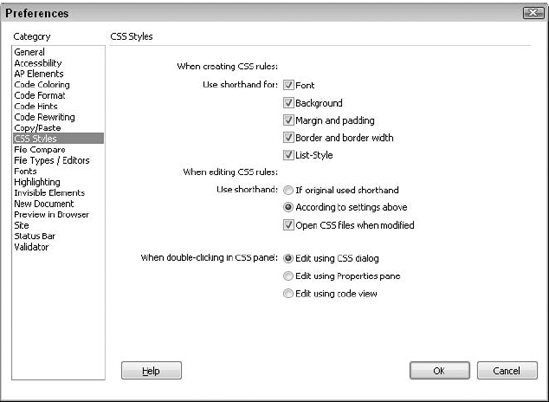
Figure 3-12. The CSS Styles category enables you to code the style sheet sections of your Web pages in a graphics designer–friendly manner.
The final option in this group, Open CSS Files When Modified, gives the designer a bit of a safety net when working with external CSS files. With this option enabled, Dreamweaver does indeed open the CSS file when you make a change in any of the CSS rules, whether through the CSS Style definition dialog or the Relevant CSS panel; however, it's important to understand why the CSS file is opened. If the file is not opened, Dreamweaver cannot undo the CSS modification. It's not necessary to switch to the CSS file and undo the changes from that document; Dreamweaver handles the modifications from any page linked to the external CSS file. You must, however, save the CSS file when you're done, confirming the final styles being used. Although it may seem a bit awkward to have an external file open while working on another, I recommend selecting the Open CSS Files When Modified option.
Dreamweaver gives designers the option to modify CSS styles the way they prefer. The fastest technique for beginning the modification process is to double-click a selector in the CSS Styles panel; what happens next depends on the settings of the final group of options in this preference category. Under the When Double-Clicking In CSS Panel options, there are three choices. The first, Edit Using CSS Dialog, opens Dreamweaver's standard CSS Definition dialog box. The second, Edit Using Properties Pane, reveals the Properties pane of the CSS Styles panel, if necessary, and puts the focus on the first property's value. The final option, Edit Using Code View, displays the selected rule in Code view whether it is contained in the current document or in an external file.
Dreamweaver's visual layout editor offers an approximation of your Web page's appearance in the real world of browsers — offline or online. After you've created the initial draft of your Web page, you should preview it through one or more browsers. And when your project nears completion, you should transfer the files to a server for online, real-time viewing and further testing through a File Transfer Protocol (FTP) program. Dreamweaver gives you control over all these stages of Web-page development through the Site and Preview In Browser categories.
As your Web site takes shape, you spend more time with the Files panel portion of Dreamweaver. The Site category, shown in Figure 3-13, enables you to customize the look-and-feel of your site, as well as to enter essential connection information. The available Site preferences are described in the following sections.
The full-screen Files panel is divided into two panes: one showing local files and one showing remote files on the server. By default, Dreamweaver puts the local pane on the right and the remote pane on the left. However, Dreamweaver enables you to customize that option. Like many designers, I'm used to using other FTP programs in which the remote files are on the right and the local files on the left; Dreamweaver enables me to work the way I'm used to working.
To switch the layout of your expanded Files panel, switch to full-screen mode and open the Site preferences. Select the file location you want to change to (Local Files or Remote Files) from the Always Show drop-down list or select the panel you want to change to (Right or Left) from the On The drop-down list. Be careful not to switch both options or you end up where you started!
Web pages are seldom just single HTML files. Any graphic — whether it's in the background, part of your main logo, or used on a navigational button — is uploaded as a separate file. The same is true for any additional multimedia add-ons such as audio or video files. If you've enabled File Check In/Check Out when defining your site, Dreamweaver can also track these so-called dependent files.
Enabling the Prompt checkboxes causes Dreamweaver to ask you if you'd like to move the dependent files when you transfer an HTML file. Choose to see the dialog box for Get/Check Out, Put/Check In, or both.
Tip
You're not stuck with your Dependent Files choice. If you turn off the Dependent Files prompt, you can make it appear by pressing the Alt (Option) key while clicking the Get or Put button.
You can easily forget you're online when you are busy modifying a page. You can set Dreamweaver to automatically disconnect you from an FTP site after a specified interval. The default is 30 minutes; if you want to set a different interval, you can select the FTP Connection value in the Disconnect After text box. Dreamweaver then asks if you want to continue to wait or to disconnect when the time limit is reached, but you can maintain your FTP connection regardless by deselecting this option.
Client-server communication is prone to glitches. Rather than hanging up your machine while trying to reach a server that is down or slow, Dreamweaver alerts you to an apparent problem after a set period. You can determine the number of seconds you want Dreamweaver to wait by altering the FTP Time Out value. The default is 60 seconds.
I often start a large FTP process (like uploading an entire site) and then go for my morning blast of coffee. Unfortunately, this means that I sometimes miss a prompt, such as "Do you want to overwrite this file?" or "Do you want to upload all dependent files?" With earlier versions of Dreamweaver, I'd come back an hour later (I drink a lot of coffee) and nothing would be done. Check this handy option to have Dreamweaver accept the default action for the prompt after a set number of seconds.
Warning
This action is enabled by default, but be sure you know what the default values for most dialogs are before checking this box. The default action for uploading files is to include dependent files. If you have out-of-date files on your local machine, the latest awesome logo your graphic designer uploaded last night might be overwritten.
Dreamweaver enables users to access remote FTP servers outside their network firewalls. A firewall is a security component that protects the internal network from unauthorized outsiders while enabling Internet access. To enable firewall access, enter the Firewall Host and External Port numbers in the appropriate text boxes; if you do not know these values, contact your network administrator.
Warning
If you're having trouble transferring files through the firewall via FTP, make sure the Use Firewall (in Preferences) option is enabled in the Site Definition dialog box. You can find the option on the Testing Server category.
Certain site operations, such as putting a file on the remote site, are now available in the Document window. It's common to make an edit to your page and then quickly choose the Site
Every now and then sites need to be restructured. To make sure that all the appropriate dependent files are transferred when an HTML file is moved, select the Prompt Before Moving Files On Server option.
Dreamweaver offers access to your site definitions from the Preferences dialog box. Just click the Manage Sites button to open the Manage Sites dialog box. This option is the same as choosing Manage Sites from the Sites pop-up on the Files panel.
Note
See Chapter 4 to learn how to use the site definitions.
Browser testing is an essential stage of Web page development. Previewing your Web page within the environment of a particular browser gives you a more exact representation of how it looks when viewed online. Because each browser renders the HTML with slight differences, you should preview your work in several browsers. Dreamweaver enables you to select both a primary and secondary browser, which can both be called by pressing a function key. You can name up to 18 additional browsers through the Preview In Browser category shown in Figure 3-14. This list of preferences is also called when you choose File

Figure 3-14. The Preview In Browser category lists browsers currently available for preview and enables you to modify the list.
To add a browser to your preview list, follow these steps:
Choose Edit

Select the Preview In Browser category.
Click the Add (+) button.
Enter the path to the browser file in the Path text box or click the Browse button to pick the file from the Select Browser dialog box.
After you have selected your browser application, Dreamweaver fills in the Name field. You can alter this name if you want.
If you want to designate this browser as your primary or secondary browser, select one of those checkboxes in the Defaults section.
Click OK when you're finished.
You can continue to add browsers (up to a total of 20) by following Steps 3 through 7. Click OK when you're finished.
After you've added a browser to your list, you can modify your selection by following these steps:
Open the Preview In Browser category and highlight the browser you want to alter.
Click the Edit button to open the Edit Browser dialog box.
After you've made your modifications, click OK to close the dialog box.
Tip
You can quickly designate a browser as your primary or secondary previewing choice without going through the Edit screen. From the Preview In Browser category, select the desired browser and check either Primary Browser or Secondary Browser. Note that if you already have a primary or secondary browser defined, this action overrides your previous choice.
You can also easily remove a browser from your preview list. Follow these steps:
Open the Preview In Browser category and choose the browser you want to delete from the list.
Click the Remove (−) button and click OK.
Dreamweaver can use temporary files for previewing your work in a browser. The temporary files generally have TMPXXXXX.html-type names and are automatically deleted when you quit Dreamweaver. With this option selected, Dreamweaver previews the last saved file; if your file has been modified since the last save, Dreamweaver asks if you'd like to save the file. This option is unchecked by default.
For all its multimedia flash and visual interactivity, the Web is based on code. The more you code, the more particular about your code you are likely to become. Achieving a consistent look-and-feel to your code enhances its readability and, thus, your productivity. In Dreamweaver, you can even design the HTML code that underlies a Web page's structure.
Every time you open a new document, the default Web page already has several key elements in place, such as the language in which the page is to be rendered. Dreamweaver also enables you to customize your work environment by selecting default fonts and even the colors of your HTML code.
In the Fonts category, shown in Figure 3-15, you can control the basic language of the fonts as seen by a user's browser and the fonts that you see when programming. The Font Settings section enables you to choose Western-style fonts for Web pages to be rendered in English, one of the Asian languages — Japanese, Traditional Chinese, Simplified Chinese, Thai, or Korean — or another language, such as Arabic, Cyrillic, Greek, Hebrew, or Turkish. If you change the Font Settings in the Page Properties for a document, the font sizes defined in these preferences are used.
Dreamweaver now offers 15 encoding options on Windows and 19 on the Mac. One of the encodings, Unicode, has platform-specific configurations, so be sure to check the options before you make a selection.
In the bottom portion of the Fonts category, you can alter the default font and size for three different fonts:
Proportional Font: This font option sets the default font used in Dreamweaver's Document window to depict paragraphs, headings, and lists.
Fixed Font: In a fixed font, every character is allocated the same width. Dreamweaver uses your chosen fixed font to depict preformatted-styled text.
Code View: The Code View font is used by Dreamweaver's built-in text editor. You should probably use a monospaced font such as Courier or Monaco. A monospaced font makes it easy to count characters, which is often necessary when debugging your code.
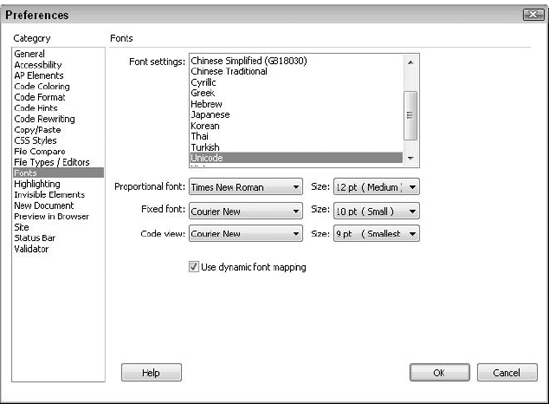
Figure 3-15. Use the Fonts category to set the font encoding for each Web page and the fonts you use when programming.
For all font options, select your font by clicking the list and highlighting your choice of font. Change the font size by selecting the value in the Size text box or by typing in a new number.
In Windows, if you select Unicode from the Font Settings list, a special option, Use Dynamic Font Mapping, appears. When this option is selected, Dreamweaver examines the current font family to make sure all the required glyphs are available. If they are not, the font family is replaced with a similar one that does keep the unknown character symbol — the blank rectangle — from appearing. It is recommended that you enable this option to preserve readability. The Macintosh always relies on dynamic mapping for the Unicode setting.
Warning
Don't be misled into thinking that by changing your Proportional Font preference to Arial or another font, you cause all your Web pages to appear automatically in that typeface. Changing these font preferences affects only the default fonts that you see when developing the Web page; the default font that the user sees is controlled by the user's browser. To ensure that a different font is used, you have to specify it for any selected text through the Text Properties inspector.
With Code Hints, your work in Code view is much more productive. You can now start typing a tag in Code view, and Dreamweaver shows you a list of available codes. Start typing <b and a list appears with <b> highlighted. Type <bl and <blockquote> is highlighted. After the tag you want is highlighted, just press Enter (Return) to insert the proper tag. But wait, there's more. The Code Hints also include all the available attributes for each tag, and when you add the closing > symbol, the matching closing tag can be automatically inserted for you. The Code Hints preferences shown in Figure 3-16 determine how Code Hints work for you.
Dreamweaver gives you two ways to handle code completion. The first option, After Typing "</", works by inserting the closing tag after you enter the first two characters. This has become my preferred technique because it allows me to enter the opening tag, the enclosed code, and then to close it with just two characters.
If you prefer the legacy method, choose the After Typing The Open Tag's ">" option. With this option selected, after I type <b> into Code view, the corresponding </b> will be added as soon as I type the last > in the bold tag.
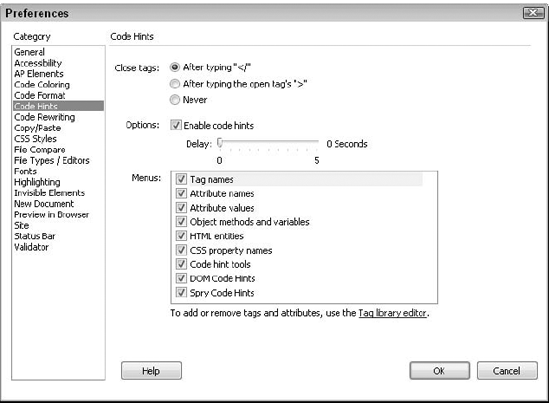
Figure 3-16. Code Hints speed your coding while keeping your entries accurate, whether you're working in HTML or CSS.
Auto Tag Completion is one of my favorite features in Dreamweaver, and it definitely keeps me from forgetting those pesky closing tags. Whichever method suits you best, I recommend you select one of them and speed up your coding.
The exception to Dreamweaver's policy of not altering imported code occurs when HTML or other code is incorrectly structured. Dreamweaver automatically fixes tags that are nested in the wrong order or have additional, unnecessary closing tags — unless you tell Dreamweaver otherwise by setting up the Code Rewriting preferences accordingly (see Figure 3-17).

Figure 3-17. The Code Rewriting category can be used to protect nonstandard HTML from being automatically changed by Dreamweaver.
Dreamweaver accommodates many different types of markup languages, not just HTML, through the Never Rewrite Code In Files With Extensions option. Moreover, you can prevent Dreamweaver from encoding special characters such as spaces, tildes, and ampersands in URLs or attribute values. Dreamweaver is now extremely flexible. The following sections describe each of the options available through the Code Rewriting category.
When enabled, this option repairs incorrectly placed tags. For example, if a file contains the following line:
<h3><b>Welcome to the Monkey House!</h3></b>
Dreamweaver rewrites it as follows:
<h3><b>Welcome to the Monkey House!</b></h3>
Open that same file with this option turned off, and Dreamweaver highlights the misplaced code in the Document window. Double-clicking the code brings up a window with a brief explanation.
In general, static Web pages require each form element to be uniquely named; with this option selected, you can quickly insert a series of text fields with similar attributes and be assured that they are individually named. However, with dynamic applications, the names may be supplied dynamically, and you don't want that code overwritten. Uncheck this box to prevent Dreamweaver from renaming all your form elements.
When you're editing your code by hand, it's fairly easy to miss a closing tag. Dreamweaver cleans up such code if you enable the Remove Extra Closing Tags option. You may, for example, have the following line in a previously edited file:
<p>And now back to our show...</p></i>
Notice that the closing italic tag, </i>, has no matching opening partner. If you open this file in Dreamweaver with the Remove option enabled, Dreamweaver plucks out the offending </i>.
Tip
In some circumstances, you want to ensure that your pages remain as originally formatted. If you edit pages in Dreamweaver that have been preprocessed by a server unknown to Dreamweaver (prior to displaying the pages), be sure that you disable both the Fix Invalidly Nested And Unclosed Tags option, where possible, and the Remove Extra Closing Tags option.
If you're editing a lot of Web pages created on another system, you should enable the Warn When Fixing Or Removing Tags option. If this setting is turned on, Dreamweaver displays a list of changes that have been made to your code in the HTML Corrections dialog box. The changes can be quite extensive when Dreamweaver opens what it regards as a poorly formatted page.
Warning
Remember that after you've enabled these Rewrite Code options, the fixes occur automatically. If this sequence happens to you by mistake, immediately close the file (without saving it!), disable the Code Rewriting preferences options, and reopen the document.
Many of the database connectivity programs, such as ColdFusion, use proprietary tags embedded in a regular Web page to communicate with their servers. Dreamweaver enables you to explicitly protect file types identified with a particular file extension.
To enter a new file type in the Never Rewrite Code options, select the In Files With Extensions field. Enter the file extension of the file type, including the period, at the end of the list. Be sure to separate your extensions from the others in the list with a space on either side.
By encoding special characters such as <, >, &, and " in attribute values, Dreamweaver ensures that the characters are interpreted correctly by the browser. This works well for static pages, but many dynamic pages use the same characters in their server-side code. If you find that your application server is misinterpreting attributes with these characters, disable the Encode <, >, &, And " In Attribute Values Using & option.
In addition to the rewriting of proprietary tags, many middleware vendors face another problem when trying to integrate with Dreamweaver. By default, earlier versions of Dreamweaver encoded all URLs so that Unix servers could understand them. The encoding converted all special characters to their decimal equivalents, preceded by a percent sign. Spaces became %20, tildes (∼) became %7E, and ampersands were converted to &. Although this is valid for Unix servers and helps to make the Dreamweaver code more universal, it can cause problems for many other types of application servers.
Dreamweaver gives you the option to disable the URL encoding, if necessary, or choose the type of encoding you prefer for special characters. If you choose to encode them using &#, Dreamweaver uses numeric character entities; this is the default option. Select the Encode Special Characters In URLs Using % option and Dreamweaver uses decimal equivalents.
In general, however, it's best to leave the URL encoding option set to the default unless you find your third-party tags being rewritten destructively.
HTML code is a combination of the tags that structure the language and the text that provides the content. A Web page designer often has difficulty distinguishing swiftly between the two — and finding the right code to modify. Dreamweaver enables you to set color preferences for the code as it appears in Code view or the Code inspector. You can not only alter colors for the background, default tags, and text and general comments, but also specify certain tags to get certain colors.
Dreamweaver now enables you to specify color-coding for individual document types. If you want different code coloring in VBScript documents, HTML, and PHP documents, you can customize the coloring for each individually. The only color on the main dialog box is the default background color. This isn't the page background color, but the Code view background color.
To modify any of the elements for a specific document type, select the document type as illustrated in Figure 3-18 and click Edit Coloring Scheme.
After you click Edit Coloring Scheme, you get the Edit Coloring Scheme For HTML dialog box, which enables you to change every facet of Dreamweaver's color coding, as shown in Figure 3-19.
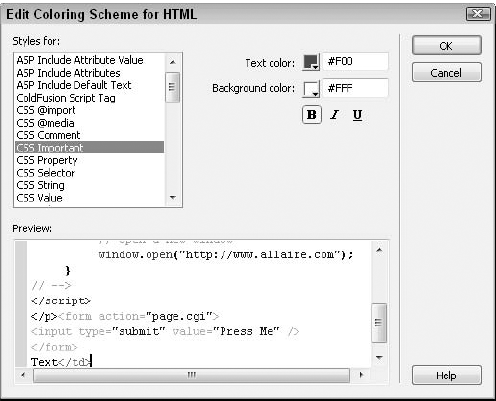
Figure 3-19. The Edit Coloring Scheme dialog box provides a method to completely customize the way you view your raw page code.
The left-hand Styles For box contains every type of tag you could ever want to color. Just select a tag type and then click the color swatch to select one of the 216 colors displayed in the color picker. After the color picker opens, you can also choose the small palette icon to select from the full range of colors available to your system. The color picker also enables you to use the Eyedropper tool to pick a color from the Document window.
As you change colors, you can see a preview of how your code looks in the Preview window.
Dreamweaver includes a fantastic tool for customizing your HTML with the easy-to-use, point-and-click preferences category called Code Format. Most of your HTML code parameters can be controlled through the Code Format category.
In the Code Format category, you can also decide whether to use indentations — and if so, whether to use spaces or tabs and how many of each — or to turn off indents for major elements such as tables and frames. You can also globally control the case of your HTML tags and their attributes. As you can see in Figure 3-20, the Code Format category is full-featured.
To examine the available options in the Code Format category, separate them into four areas: indent control, line control, case control, and centering.
Indenting your code generally makes it more readable. Dreamweaver defaults to indenting most HTML tags with two spaces, giving extra indentation grouping to tables and frames. All these parameters can be altered through the Code Format category of the Preferences dialog box.
The first indent option enables indenting, and you can switch from spaces to tabs. To permit indenting, make sure a checkmark is displayed in the Indent checkbox. If you prefer your code to be displayed flush left, turn off the Indent option altogether.
To use tabs instead of the default spaces, select Tabs from the drop-down list. If you anticipate transferring your code to a word-processing program for formatting and printing, you should use tabs; otherwise, stay with the default spaces.
Dreamweaver formats both tables and frames as special indentation groups. Within each of these structural elements, the related tags are indented (or nested) more than the initial two spaces. As you can see in Listing 3-1, each table row (<tr>) is indented within the table tag, and the table data tags (<td>) are nested within the table row.
Example 3-1. An indented code sample
<table border="1" width="75%"> <tr> <td>Row 1, Column 1</td> <td>Row 1, Column 2</td> <td>Row 1, Column 3</td> </tr> <tr> <td>Row 2, Column 1</td> <td>Row 2, Column 2</td> <td>Row 2, Column 3</td> </tr> </table>
The other two items in the indent control section of the Code Format preferences category are Indent and Tab Size. Change the value in Indent to establish the size of indents using spaces. To alter the size of tab indents, change the Tab Size value.
The browser is responsible for ultimately formatting an HTML page for viewing. This formatting includes wrapping text according to each user's screen size and the placement of the paragraph tags (<p>...</p>). Therefore, you control how your code wraps in your HTML editor. You can turn off the automatic wrapping feature or set it for a particular column through the line control options of the Code Format category.
Tip
If you're using Code view or the Code inspector, selecting the Word Wrap option overrides the Automatic Wrapping setting in the Code Format category.
The Line Break Type setting determines which line break character is appended to each line of the page. Each of the major operating systems employs a different ending character: Macintosh uses a carriage return (CR), Unix uses a line feed (LF), and Windows uses both (CR LF). If you know the operating system for your remote server, choosing the corresponding line break character ensures that the file has the correct appearance when viewed online. Click the drop-down arrow next to Line Break Type to select your system.
Warning
The operating system for your local development machine may be different from the operating system of your remote server. If so, using the Line Break Type option may cause your HTML to appear incorrect when viewed through a simple text editor (such as Notepad or TextEdit). Dreamweaver's Code view and Code inspector, however, do render the code correctly.
The case of HTML tags is becoming more and more important. In XHTML, all tags and attribute names must be in lowercase. If you're coding in regular HTML, case is only a personal preference among Web designers. That said, some Webmasters consider case a serious preference and insist that their code be all uppercase, all lowercase, or a combination of uppercase and lowercase. Dreamweaver gives you control over the tags and attributes it creates, as well as over case conversion for files that Dreamweaver imports. The Dreamweaver default for both tags and attributes is lowercase.
Tip
Lowercase tags and attributes are also less fattening, according to the W3C. Files with lowercase tag names and attributes compress better and thus transmit faster.
You can also use Dreamweaver to standardize the letter case in tags of previously saved files. To alter imported files, select the Override Case Of Tags and/or the Override Case Of Attributes options. When enabled, these options enforce your choices made in the Case For Tags and Case For Attributes option boxes in any file Dreamweaver loads. Again, be sure to save your file to keep the changes.
The TD Tag option ensures that there is no line break after the <td> tag in your document. Putting a line break after the <td> can create display anomalies in some browsers, such as unwanted space. I recommend leaving this one checked.
Just as the format of HTML code matters to many Web designers, so does the format of the embedded or attached CSS code. Clicking the CSS button opens the CSS Source Format Options dialog box (see Figure 3-21), which offers a range of controls to stylize your style sheets.
Most designers find that, like HTML code, CSS code is easier to read if it is indented. The Indent Properties option enables you to set the amount of tabs or spaces to use for each indentation. Readability is also enhanced by selecting the Each Property On Separate Line option, which has two related options: you can force the opening brace ({) onto a separate line if you prefer and restrict the rule to a single line if there is only one property. You'll also have the choice to keep all your selectors on the same line and to place a blank line between defined rules.
The format of your CSS, perhaps even more than your HTML, is completely up to the designer's personal preferences. I try to strike a balance between readability and compactness by selecting all the options except Opening Brace On Separate Line and Blank Line Between Rules.
Note
Not only can you customize your general code and CSS preferences, but with Dreamweaver's Tag Library Editor you can modify all the various tags individually — as well as import entire new tag sets. For details on how the Tag Library Editor works, see Chapter 33.
Dreamweaver offers the capability to validate against multiple HTML schemes and server-side languages. You can even choose which types of errors you'd like Dreamweaver to warn you about. In Figure 3-22, notice that you can choose just the specs you want to support.
The Validate Against list includes the following entries:
Basic ColdFusion
ColdFusion 3.0
ColdFusion 3.1
ColdFusion 4.0
ColdFusion 4.5
ColdFusion 5.0
ColdFusion MX
ColdFusion MX 7
Synchronized Multiple Integration Language 1.0
Wireless Markup Language
Clicking Options enables you to choose which types of errors you want Dreamweaver to display and check for. The Display list includes Errors, Warnings, Custom Messages, and Nesting Errors. The Check For list includes Quotes In Text and Entities In Text. All options are checked by default, as shown in Figure 3-23.
Creating Web pages, like any design job, is easier when the tools fit your hands. Through Preferences, you can make Dreamweaver work the way you work. When you're examining and setting Dreamweaver's preferences, keep these points in mind:
Dreamweaver enables you to customize your Web page design and HTML coding environment through a series of easy-to-use, point-and-click categories.
Dreamweaver's startup options include a welcome screen that brings your recent documents within one-click reach as well as the opportunity to automatically reopen all your documents from your previous session.
You can decide how best to use cutting-edge features, such as AP elements and style sheets, depending on the degree of cross-browser and backward compatibility you need.
Dreamweaver gives you plenty of elbow room for previewing and testing by providing for 20 selections on your browser list.
Set the level of validation you want to strive for through the Validator preferences.
In the next chapter, you learn how to define a site in Dreamweaver.
